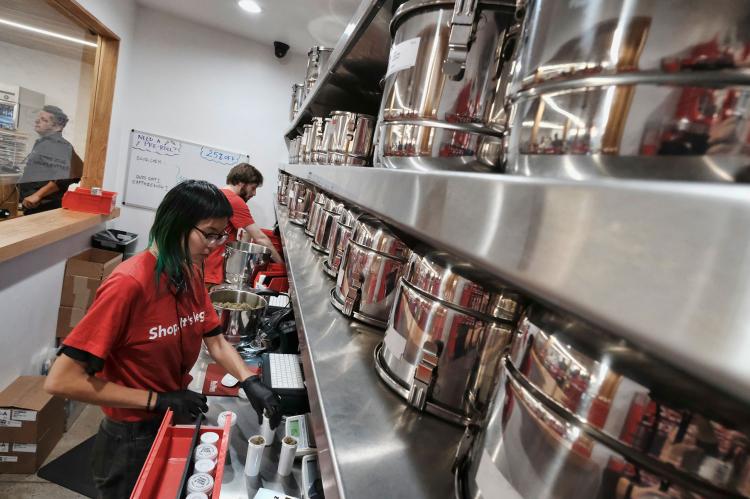How to tell legal from illegal cannabis dispensaries in California
On January 1st, 2018, recreational cannabis became legal in the state of California, after over two decades of medical-only legalization. Over the next few months, some dispensaries would go from having cannabis out on the counter for people to smell and inspect to only having pre-packaged and sealed cannabis. Free deals for newcomers would vanish. Prices skyrocketed. And high taxes were added on top of that, adding up to over 40% in some counties.
But at other dispensaries, prices remain just as low as before. You can still inspect the buds up-close, probably see them weighed, and they’ll likely even give you a free joint just for discovering their shop. So if you’re a patron just looking for a place to get a price-conscious bag, it’d be an easy decision to choose between the two types of dispensaries in California—who picks expensive and uptight over reasonably priced and chilled-out?
However, if you were to choose that second shop, you’d be breaking the law—it’s an unlicensed illegal dispensary. So how are cannabis lovers in California supposed to know which is which? And, does it matter?
Legal compliance in the Wild West of cannabis
In California, the amount of unlicensed illegal cannabis dispensaries is estimated to be over 3 times higher than the amount of legal ones. Between a bureaucratic nightmare with licensing, including stunning fees, limited availability, and other issues, going legal in California isn’t easy or cheap. This has resulted in a state filled with dispensaries that were previously legal for medical patients but are now illegal.
Many people risked everything they had to start a legal business, but the cheap illegal competition has meant the ruin of their legal businesses.
There are many other benefits in supporting legally compliant dispensaries. Adam Hijazi, owner of the legally compliant Long Beach Green Room, said, “When you buy legally, you’re getting a far better product. You’re getting better customer service, facilities with security, with cameras, and with guards.” He also noted that legal shops tend to offer more stable jobs that pay better, and that the immense taxes legal dispensary owners pay are invested into the community.
Another huge issue is testing for safety and content. Alex Traverso, Assistant Chief of Communications for the Bureau of Cannabis Control (BCC), shared with us that just two weeks ago they tested cartridges from 45 illegal shops—and a whopping 75% of them failed the vitamin E acetate tests, meaning they contain the commonly cited source of the vape crisis. Traverso commented, “I know I don’t want to be taking that chance.”
Luckily, there will be a quick way to know
Because many licensed dispensaries simply upgraded their old stores to become legally compliant, the differences between the two kinds of shops aren’t always apparent to customers.
Aiming to make the distinction as simple as knowing if a restaurant’s up to health code, the BCC created an emblem to be placed on legal cannabis business fronts. These emblems have a unique QR code that pulls up the licensing information of the business.
If you haven’t used a QR code with your smartphone before, it’s really easy: just pull up your camera, hold it over the QR code, and click the notification that appears on your screen. Industry personnel in delivery and distribution will be required to have one on their persons as well.
If there is no QR code, try checking CAPotCheck.com where you can search by location, license type, and other handy filters. There is also an LA-specific map here.
Since the early months of legalization, Leafly has listed only licensed businesses. Licenses can be found under a dispensary’s “Info” section.
In addition to the QR code emblems, there are also subtle ways of telling if a dispensary is legal, like asking about taxes and testing, or looking for visual cues. According to Traverso, “If you go into a shop and still see big bags and jars of cannabis on the shelves instead of individually packaged stuff, there’s a good chance that it’s not a legal shop.”
He added that it’s wise to know if a shop is legal before you get up to its door, or before leaving the house, if possible—once you’re already at the shop, it can be awkward and time-consuming to adjust the situation.
Stay tuned and spread the word
Traverso says the QR emblems are becoming mandatory for all licensed businesses in coming months, and he expects no pushback. “The licensees that I’ve talked to want people to know that they are legit,” he said.
Speaking to the extensive compliance demands, Traverso said, “Everything they are doing is to be legit. They want to tell the public, ‘this is a shop that does everything by the book.’’’ He added that the QR emblems are really a badge of honor, a nod to all of the hard work these businesses have put into California’s fledgling industry.
The program has already started to roll out and should be completed within a few months. The legally compliant dispensary owner we talked with, Adam Hijazi, already has his emblem, telling us that the program is off to a good start.
“I think it’s very helpful that these programs are coming up. Even though at first it’s going to be hard for them to recognize—of course it is, it’s the first time this is happening.”
Educating the public is never easy, and this is no exception to that rule. “Some patients or customers come in, notice it, and ask questions about [the QR emblems]—but really most of the time it’s us talking about it, so that way they can notice it,” Hijazi said. He says that this effort to educate the public is very much worth it, and that the California cannabis industry is worth it. “We gotta keep going at it. Insistence breaks the resistance.”
- Log in to post comments

